seats FORD MUSTANG 2019 Owners Manual
[x] Cancel search | Manufacturer: FORD, Model Year: 2019, Model line: MUSTANG, Model: FORD MUSTANG 2019Pages: 495, PDF Size: 8.04 MB
Page 4 of 495
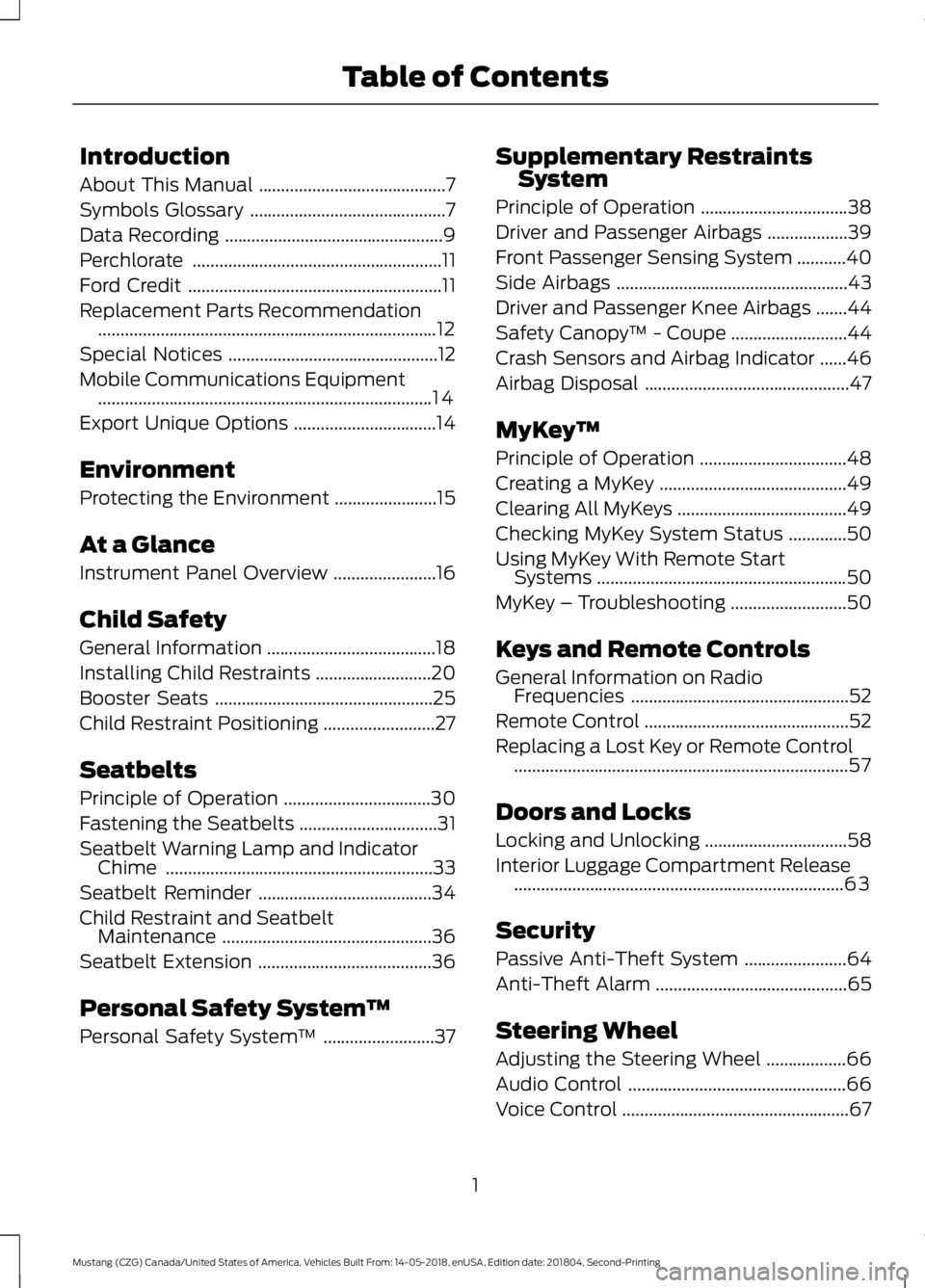
Introduction
About This Manual
..........................................7
Symbols Glossary ............................................
7
Data Recording .................................................
9
Perchlorate ........................................................
11
Ford Credit .........................................................
11
Replacement Parts Recommendation ........................................................................\
....
12
Special Notices ...............................................
12
Mobile Communications Equipment ........................................................................\
...
14
Export Unique Options ................................
14
Environment
Protecting the Environment .......................
15
At a Glance
Instrument Panel Overview .......................
16
Child Safety
General Information ......................................
18
Installing Child Restraints ..........................
20
Booster Seats .................................................
25
Child Restraint Positioning .........................
27
Seatbelts
Principle of Operation .................................
30
Fastening the Seatbelts ...............................
31
Seatbelt Warning Lamp and Indicator Chime ............................................................
33
Seatbelt Reminder .......................................
34
Child Restraint and Seatbelt Maintenance ...............................................
36
Seatbelt Extension .......................................
36
Personal Safety System ™
Personal Safety System ™.........................
37 Supplementary Restraints
System
Principle of Operation .................................
38
Driver and Passenger Airbags ..................
39
Front Passenger Sensing System ...........
40
Side Airbags ....................................................
43
Driver and Passenger Knee Airbags .......
44
Safety Canopy ™ - Coupe..........................
44
Crash Sensors and Airbag Indicator ......
46
Airbag Disposal ..............................................
47
MyKey ™
Principle of Operation .................................
48
Creating a MyKey ..........................................
49
Clearing All MyKeys ......................................
49
Checking MyKey System Status .............
50
Using MyKey With Remote Start Systems ........................................................
50
MyKey – Troubleshooting ..........................
50
Keys and Remote Controls
General Information on Radio Frequencies .................................................
52
Remote Control ..............................................
52
Replacing a Lost Key or Remote Control ........................................................................\
...
57
Doors and Locks
Locking and Unlocking ................................
58
Interior Luggage Compartment Release ........................................................................\
..
63
Security
Passive Anti-Theft System .......................
64
Anti-Theft Alarm ...........................................
65
Steering Wheel
Adjusting the Steering Wheel ..................
66
Audio Control .................................................
66
Voice Control ...................................................
67
1
Mustang (CZG) Canada/United States of America, Vehicles Built From: 14-05-2018, enUSA, Edition date: 201804, Second-Printing Table of Contents
Page 5 of 495
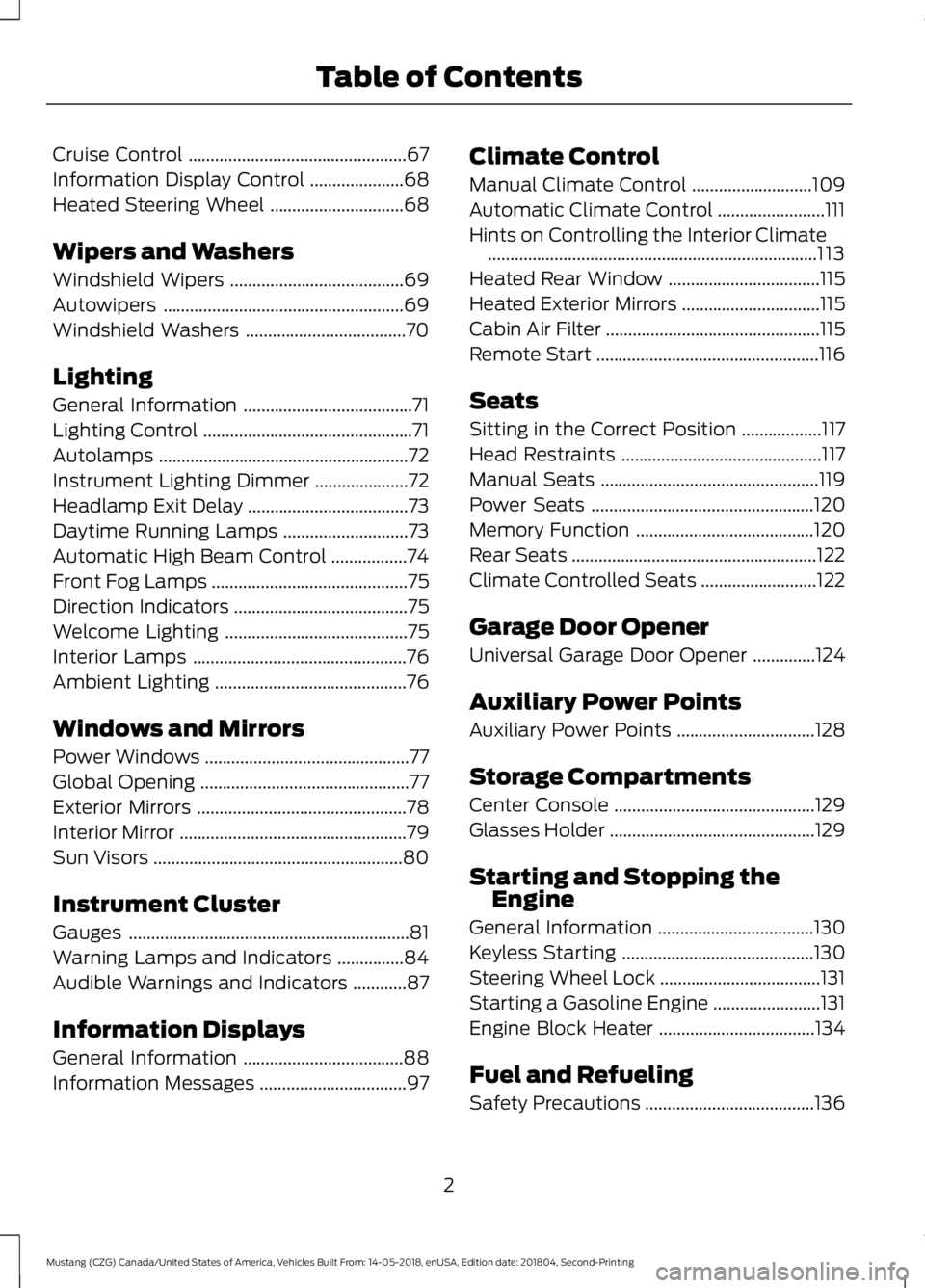
Cruise Control
.................................................67
Information Display Control .....................
68
Heated Steering Wheel ..............................
68
Wipers and Washers
Windshield Wipers .......................................
69
Autowipers ......................................................
69
Windshield Washers ....................................
70
Lighting
General Information ......................................
71
Lighting Control ...............................................
71
Autolamps ........................................................
72
Instrument Lighting Dimmer .....................
72
Headlamp Exit Delay ....................................
73
Daytime Running Lamps ............................
73
Automatic High Beam Control .................
74
Front Fog Lamps ............................................
75
Direction Indicators .......................................
75
Welcome Lighting .........................................
75
Interior Lamps ................................................
76
Ambient Lighting ...........................................
76
Windows and Mirrors
Power Windows ..............................................
77
Global Opening ...............................................
77
Exterior Mirrors ...............................................
78
Interior Mirror ...................................................
79
Sun Visors ........................................................
80
Instrument Cluster
Gauges ...............................................................
81
Warning Lamps and Indicators ...............
84
Audible Warnings and Indicators ............
87
Information Displays
General Information ....................................
88
Information Messages .................................
97Climate Control
Manual Climate Control
...........................
109
Automatic Climate Control ........................
111
Hints on Controlling the Interior Climate ........................................................................\
..
113
Heated Rear Window ..................................
115
Heated Exterior Mirrors ...............................
115
Cabin Air Filter ................................................
115
Remote Start ..................................................
116
Seats
Sitting in the Correct Position ..................
117
Head Restraints .............................................
117
Manual Seats .................................................
119
Power Seats ..................................................
120
Memory Function ........................................
120
Rear Seats .......................................................
122
Climate Controlled Seats ..........................
122
Garage Door Opener
Universal Garage Door Opener ..............
124
Auxiliary Power Points
Auxiliary Power Points ...............................
128
Storage Compartments
Center Console .............................................
129
Glasses Holder ..............................................
129
Starting and Stopping the Engine
General Information ...................................
130
Keyless Starting ...........................................
130
Steering Wheel Lock ....................................
131
Starting a Gasoline Engine ........................
131
Engine Block Heater ...................................
134
Fuel and Refueling
Safety Precautions ......................................
136
2
Mustang (CZG) Canada/United States of America, Vehicles Built From: 14-05-2018, enUSA, Edition date: 201804, Second-Printing Table of Contents
Page 7 of 495
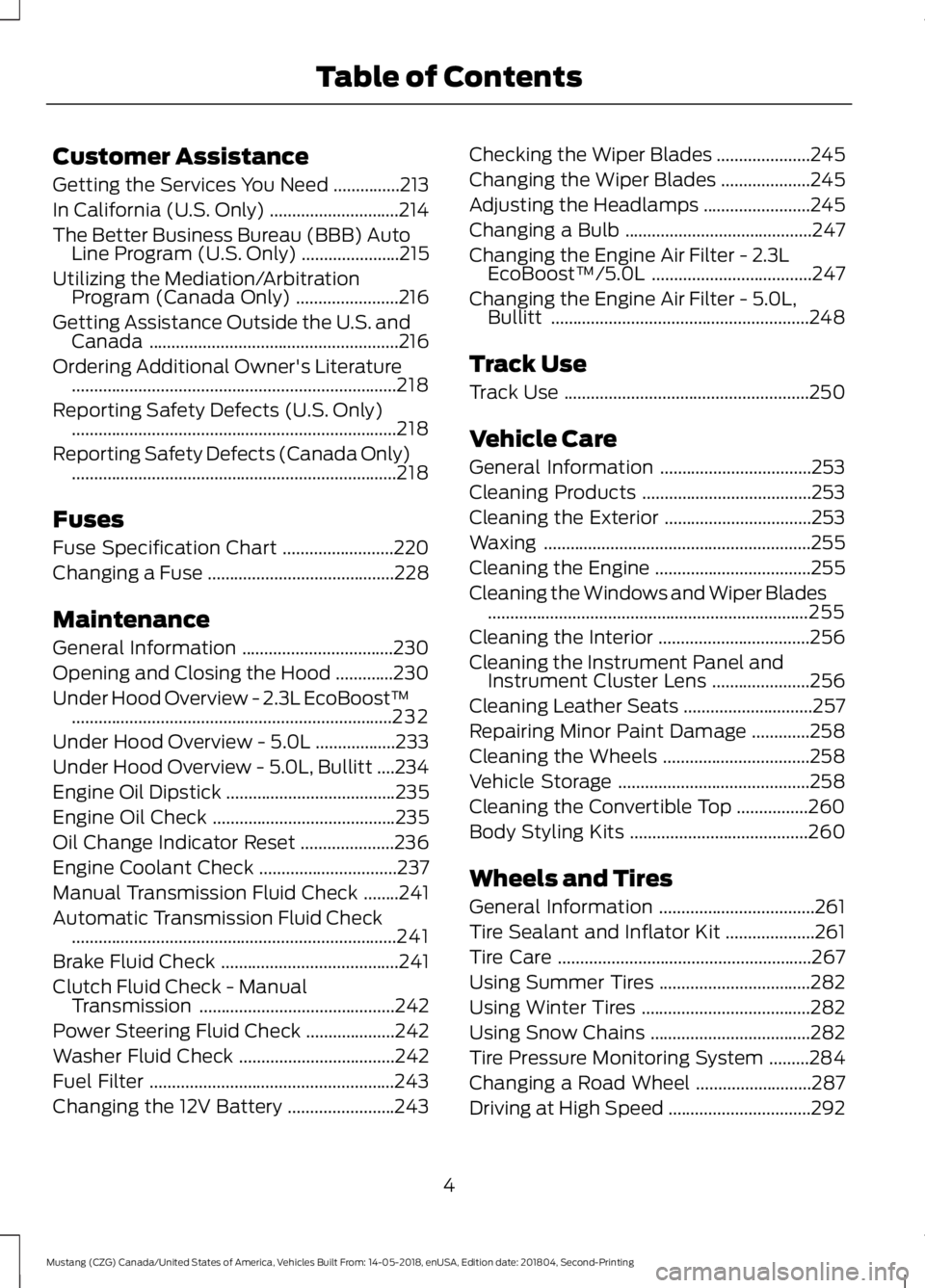
Customer Assistance
Getting the Services You Need
...............213
In California (U.S. Only) .............................
214
The Better Business Bureau (BBB) Auto Line Program (U.S. Only) ......................
215
Utilizing the Mediation/Arbitration Program (Canada Only) .......................
216
Getting Assistance Outside the U.S. and Canada ........................................................
216
Ordering Additional Owner's Literature ........................................................................\
.
218
Reporting Safety Defects (U.S. Only) ........................................................................\
.
218
Reporting Safety Defects (Canada Only) ........................................................................\
.
218
Fuses
Fuse Specification Chart .........................
220
Changing a Fuse ..........................................
228
Maintenance
General Information ..................................
230
Opening and Closing the Hood .............
230
Under Hood Overview - 2.3L EcoBoost™ ........................................................................\
232
Under Hood Overview - 5.0L ..................
233
Under Hood Overview - 5.0L, Bullitt ....
234
Engine Oil Dipstick ......................................
235
Engine Oil Check .........................................
235
Oil Change Indicator Reset .....................
236
Engine Coolant Check ...............................
237
Manual Transmission Fluid Check ........
241
Automatic Transmission Fluid Check ........................................................................\
.
241
Brake Fluid Check ........................................
241
Clutch Fluid Check - Manual Transmission ............................................
242
Power Steering Fluid Check ....................
242
Washer Fluid Check ...................................
242
Fuel Filter .......................................................
243
Changing the 12V Battery ........................
243Checking the Wiper Blades
.....................
245
Changing the Wiper Blades ....................
245
Adjusting the Headlamps ........................
245
Changing a Bulb ..........................................
247
Changing the Engine Air Filter - 2.3L EcoBoost™/5.0L ....................................
247
Changing the Engine Air Filter - 5.0L, Bullitt ..........................................................
248
Track Use
Track Use .......................................................
250
Vehicle Care
General Information ..................................
253
Cleaning Products ......................................
253
Cleaning the Exterior .................................
253
Waxing ............................................................
255
Cleaning the Engine ...................................
255
Cleaning the Windows and Wiper Blades ........................................................................\
255
Cleaning the Interior ..................................
256
Cleaning the Instrument Panel and Instrument Cluster Lens ......................
256
Cleaning Leather Seats .............................
257
Repairing Minor Paint Damage .............
258
Cleaning the Wheels .................................
258
Vehicle Storage ...........................................
258
Cleaning the Convertible Top ................
260
Body Styling Kits ........................................
260
Wheels and Tires
General Information ...................................
261
Tire Sealant and Inflator Kit ....................
261
Tire Care .........................................................
267
Using Summer Tires ..................................
282
Using Winter Tires ......................................
282
Using Snow Chains ....................................
282
Tire Pressure Monitoring System .........
284
Changing a Road Wheel ..........................
287
Driving at High Speed ................................
292
4
Mustang (CZG) Canada/United States of America, Vehicles Built From: 14-05-2018, enUSA, Edition date: 201804, Second-Printing Table of Contents
Page 16 of 495
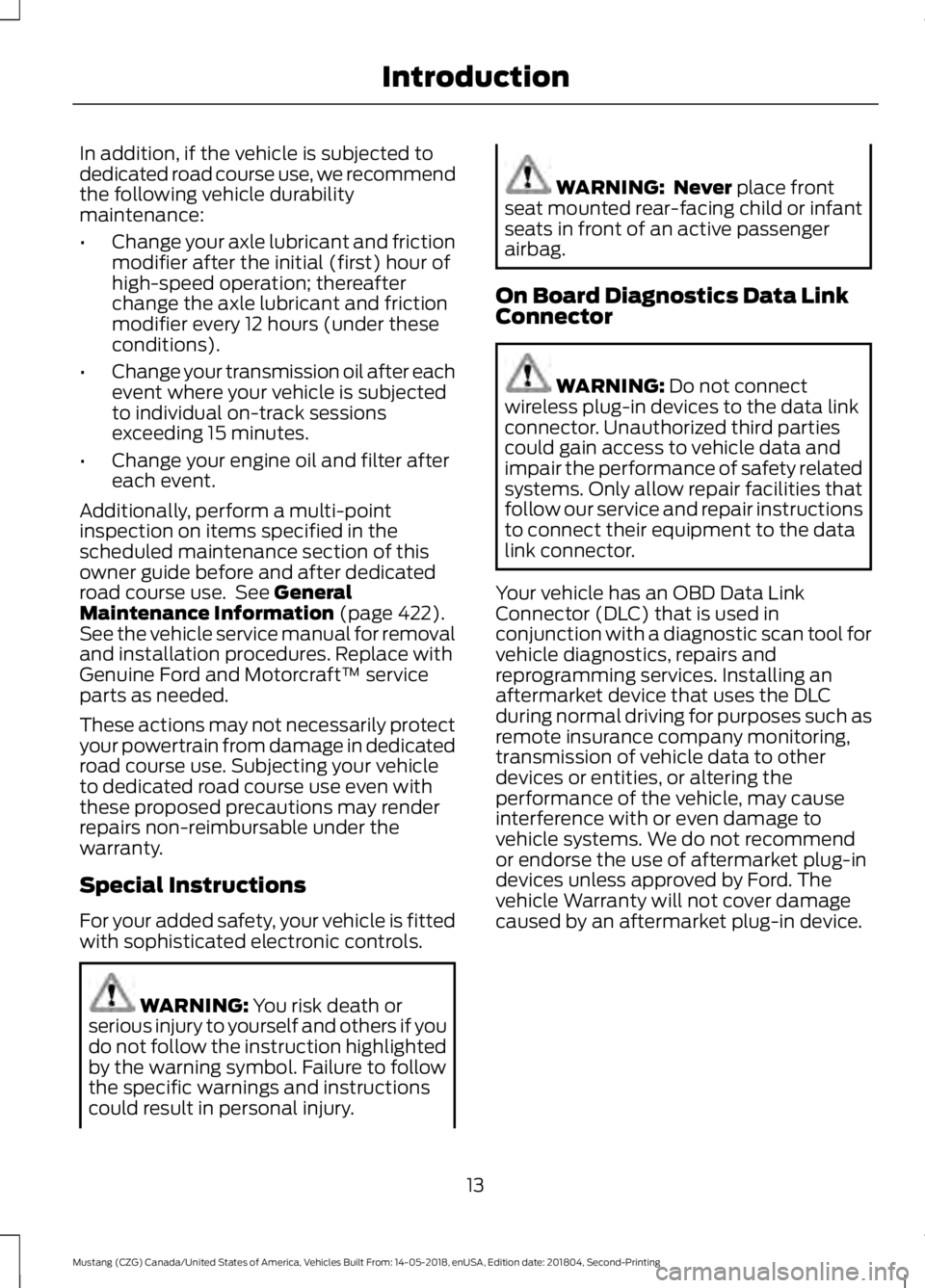
In addition, if the vehicle is subjected to
dedicated road course use, we recommend
the following vehicle durability
maintenance:
•
Change your axle lubricant and friction
modifier after the initial (first) hour of
high-speed operation; thereafter
change the axle lubricant and friction
modifier every 12 hours (under these
conditions).
• Change your transmission oil after each
event where your vehicle is subjected
to individual on-track sessions
exceeding 15 minutes.
• Change your engine oil and filter after
each event.
Additionally, perform a multi-point
inspection on items specified in the
scheduled maintenance section of this
owner guide before and after dedicated
road course use. See General
Maintenance Information (page 422).
See the vehicle service manual for removal
and installation procedures. Replace with
Genuine Ford and Motorcraft™ service
parts as needed.
These actions may not necessarily protect
your powertrain from damage in dedicated
road course use. Subjecting your vehicle
to dedicated road course use even with
these proposed precautions may render
repairs non-reimbursable under the
warranty.
Special Instructions
For your added safety, your vehicle is fitted
with sophisticated electronic controls. WARNING:
You risk death or
serious injury to yourself and others if you
do not follow the instruction highlighted
by the warning symbol. Failure to follow
the specific warnings and instructions
could result in personal injury. WARNING: Never
place front
seat mounted rear-facing child or infant
seats in front of an active passenger
airbag.
On Board Diagnostics Data Link
Connector WARNING:
Do not connect
wireless plug-in devices to the data link
connector. Unauthorized third parties
could gain access to vehicle data and
impair the performance of safety related
systems. Only allow repair facilities that
follow our service and repair instructions
to connect their equipment to the data
link connector.
Your vehicle has an OBD Data Link
Connector (DLC) that is used in
conjunction with a diagnostic scan tool for
vehicle diagnostics, repairs and
reprogramming services. Installing an
aftermarket device that uses the DLC
during normal driving for purposes such as
remote insurance company monitoring,
transmission of vehicle data to other
devices or entities, or altering the
performance of the vehicle, may cause
interference with or even damage to
vehicle systems. We do not recommend
or endorse the use of aftermarket plug-in
devices unless approved by Ford. The
vehicle Warranty will not cover damage
caused by an aftermarket plug-in device.
13
Mustang (CZG) Canada/United States of America, Vehicles Built From: 14-05-2018, enUSA, Edition date: 201804, Second-Printing Introduction
Page 19 of 495
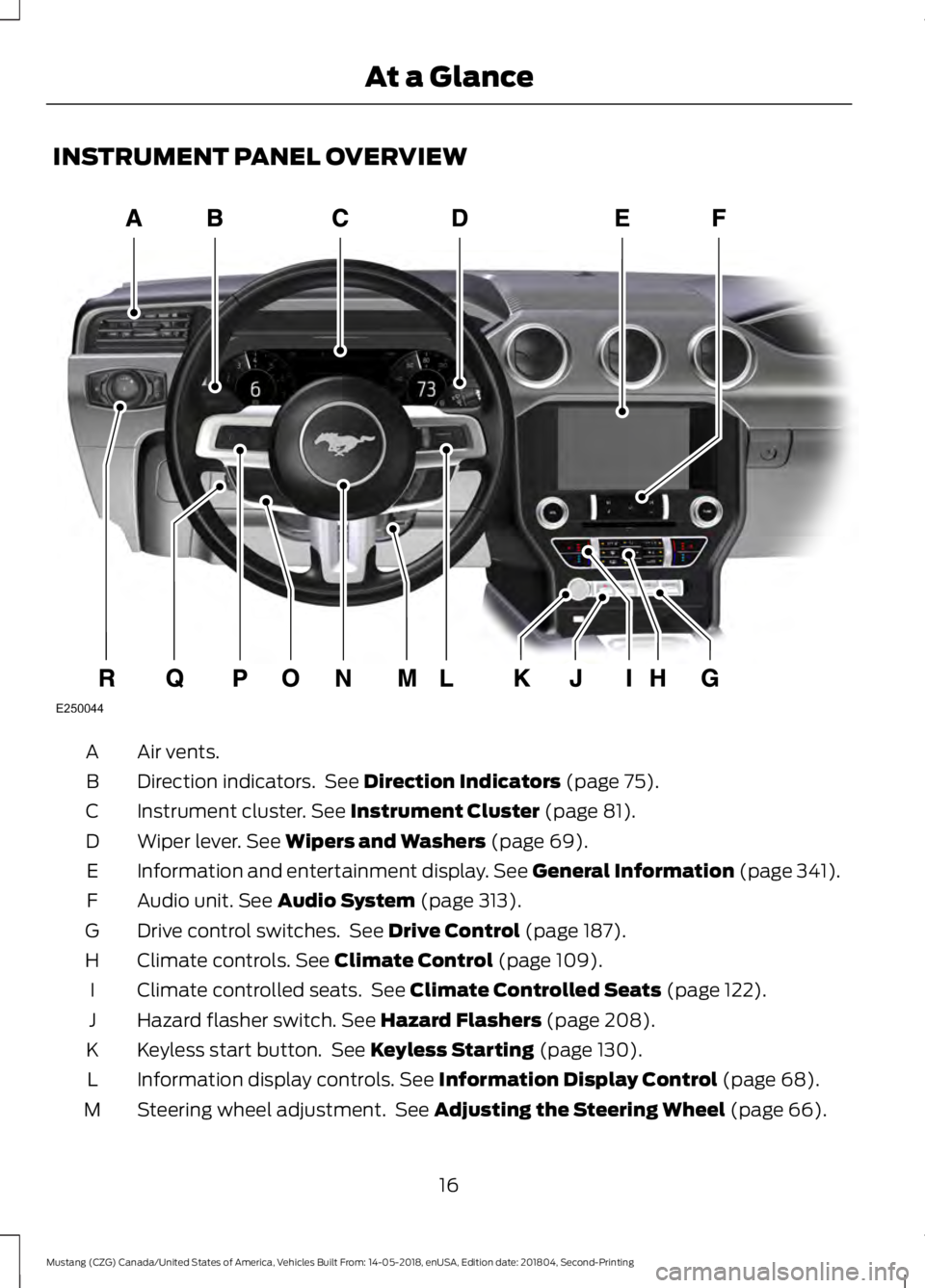
INSTRUMENT PANEL OVERVIEW
Air vents.
A
Direction indicators. See Direction Indicators (page 75).
B
Instrument cluster.
See Instrument Cluster (page 81).
C
Wiper lever.
See Wipers and Washers (page 69).
D
Information and entertainment display. See General Information (page 341).
E
Audio unit.
See Audio System (page 313).
F
Drive control switches. See
Drive Control (page 187).
G
Climate controls.
See Climate Control (page 109).
H
Climate controlled seats. See
Climate Controlled Seats (page 122).
I
Hazard flasher switch.
See Hazard Flashers (page 208).
J
Keyless start button. See
Keyless Starting (page 130).
K
Information display controls.
See Information Display Control (page 68).
L
Steering wheel adjustment. See
Adjusting the Steering Wheel (page 66).
M
16
Mustang (CZG) Canada/United States of America, Vehicles Built From: 14-05-2018, enUSA, Edition date: 201804, Second-Printing At a GlanceE250044
Page 22 of 495
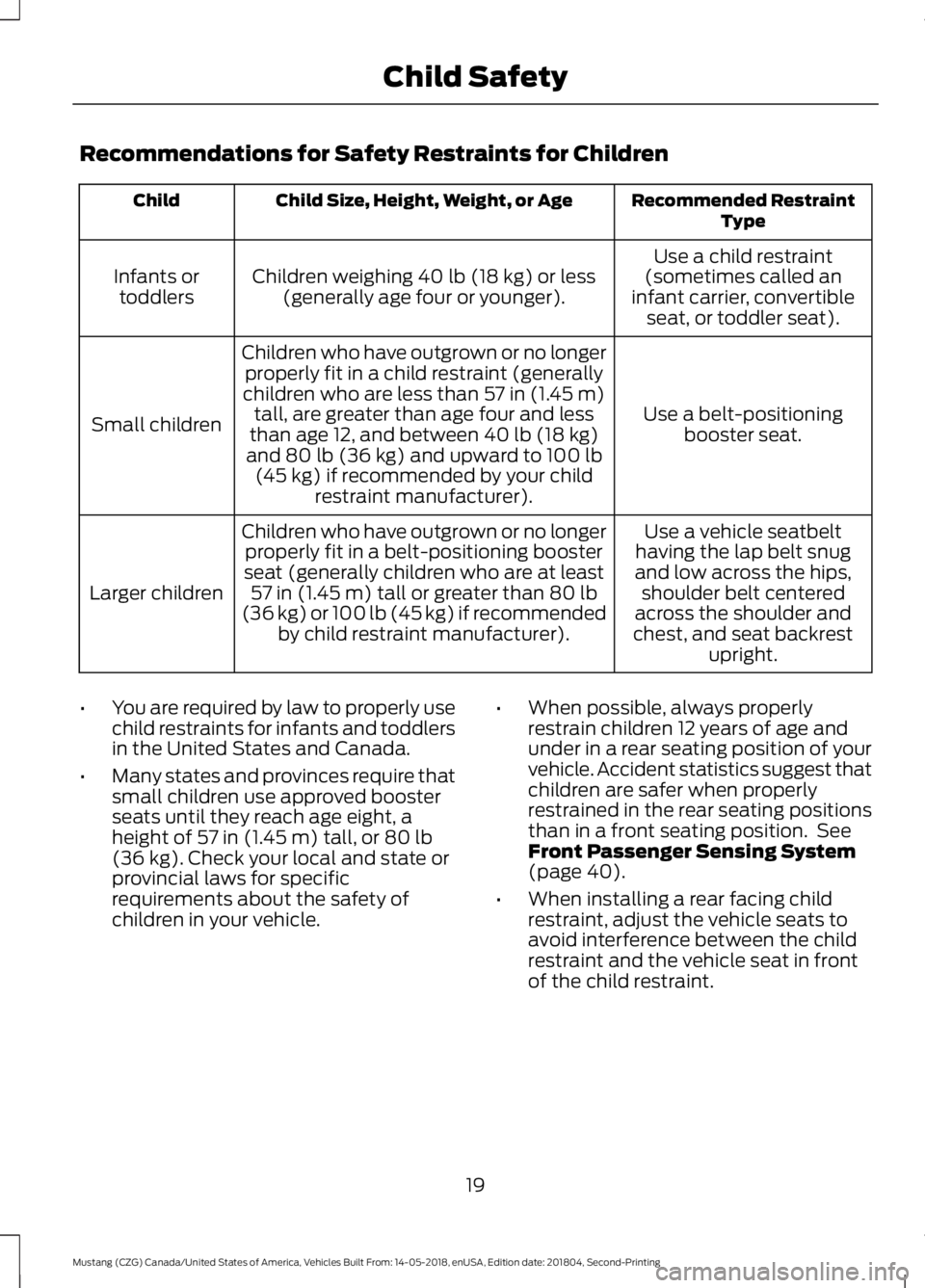
Recommendations for Safety Restraints for Children
Recommended Restraint
Type
Child Size, Height, Weight, or Age
Child
Use a child restraint
(sometimes called an
infant carrier, convertible seat, or toddler seat).
Children weighing 40 lb (18 kg) or less
(generally age four or younger).
Infants or
toddlers
Use a belt-positioningbooster seat.
Children who have outgrown or no longer
properly fit in a child restraint (generally
children who are less than
57 in (1.45 m)
tall, are greater than age four and less
than age 12, and between
40 lb (18 kg)
and 80 lb (36 kg) and upward to 100 lb
(45 kg) if recommended by your child
restraint manufacturer).
Small children
Use a vehicle seatbelt
having the lap belt snug
and low across the hips, shoulder belt centered
across the shoulder and
chest, and seat backrest upright.
Children who have outgrown or no longer
properly fit in a belt-positioning booster
seat (generally children who are at least 57 in (1.45 m)
tall or greater than 80 lb
(36 kg) or 100 lb (45 kg) if recommended by child restraint manufacturer).
Larger children
• You are required by law to properly use
child restraints for infants and toddlers
in the United States and Canada.
• Many states and provinces require that
small children use approved booster
seats until they reach age eight, a
height of
57 in (1.45 m) tall, or 80 lb
(36 kg). Check your local and state or
provincial laws for specific
requirements about the safety of
children in your vehicle. •
When possible, always properly
restrain children 12 years of age and
under in a rear seating position of your
vehicle. Accident statistics suggest that
children are safer when properly
restrained in the rear seating positions
than in a front seating position. See
Front Passenger Sensing System
(page 40).
• When installing a rear facing child
restraint, adjust the vehicle seats to
avoid interference between the child
restraint and the vehicle seat in front
of the child restraint.
19
Mustang (CZG) Canada/United States of America, Vehicles Built From: 14-05-2018, enUSA, Edition date: 201804, Second-Printing Child Safety
Page 23 of 495
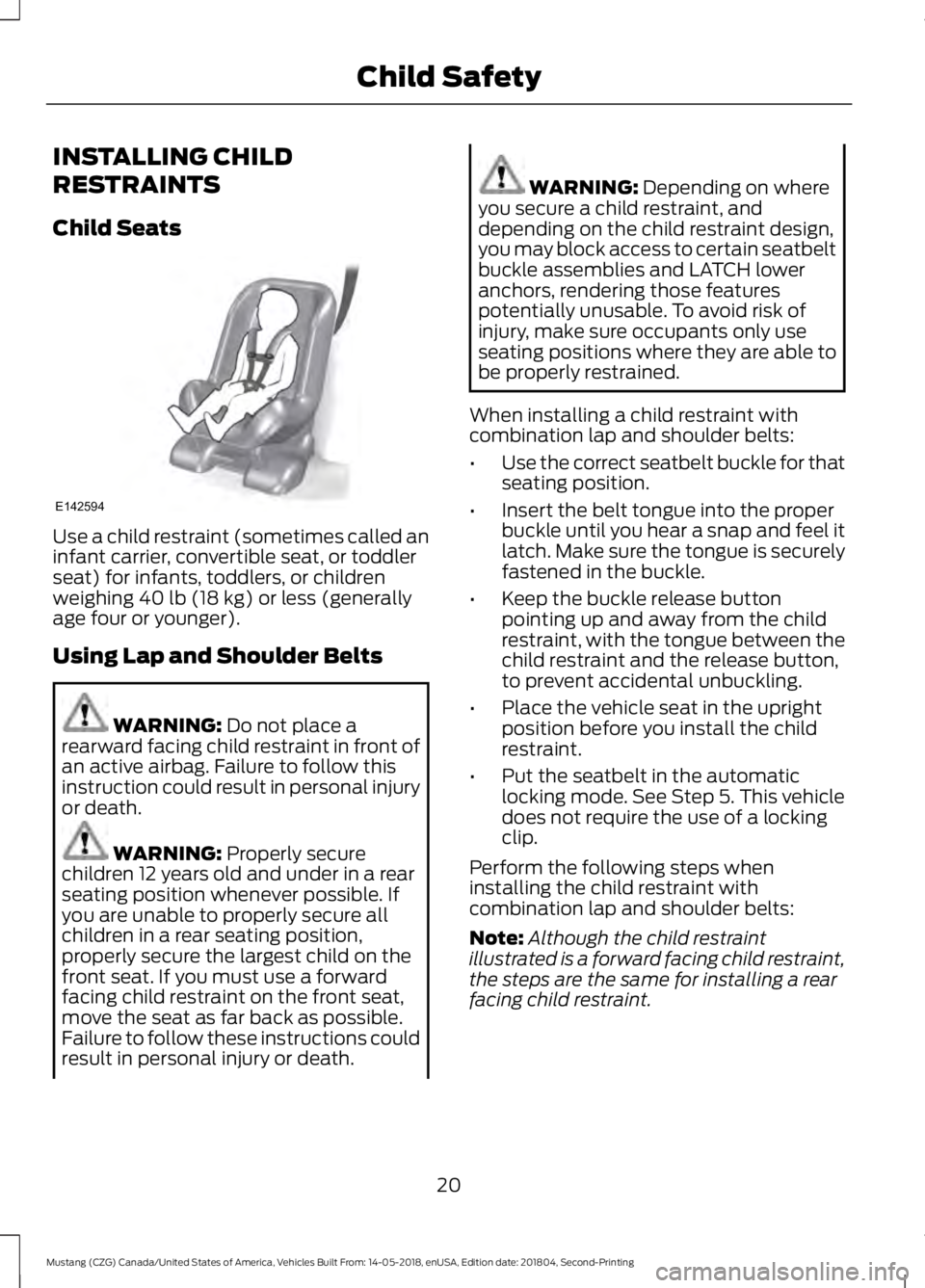
INSTALLING CHILD
RESTRAINTS
Child Seats
Use a child restraint (sometimes called an
infant carrier, convertible seat, or toddler
seat) for infants, toddlers, or children
weighing 40 lb (18 kg) or less (generally
age four or younger).
Using Lap and Shoulder Belts WARNING:
Do not place a
rearward facing child restraint in front of
an active airbag. Failure to follow this
instruction could result in personal injury
or death. WARNING:
Properly secure
children 12 years old and under in a rear
seating position whenever possible. If
you are unable to properly secure all
children in a rear seating position,
properly secure the largest child on the
front seat. If you must use a forward
facing child restraint on the front seat,
move the seat as far back as possible.
Failure to follow these instructions could
result in personal injury or death. WARNING:
Depending on where
you secure a child restraint, and
depending on the child restraint design,
you may block access to certain seatbelt
buckle assemblies and LATCH lower
anchors, rendering those features
potentially unusable. To avoid risk of
injury, make sure occupants only use
seating positions where they are able to
be properly restrained.
When installing a child restraint with
combination lap and shoulder belts:
• Use the correct seatbelt buckle for that
seating position.
• Insert the belt tongue into the proper
buckle until you hear a snap and feel it
latch. Make sure the tongue is securely
fastened in the buckle.
• Keep the buckle release button
pointing up and away from the child
restraint, with the tongue between the
child restraint and the release button,
to prevent accidental unbuckling.
• Place the vehicle seat in the upright
position before you install the child
restraint.
• Put the seatbelt in the automatic
locking mode. See Step 5. This vehicle
does not require the use of a locking
clip.
Perform the following steps when
installing the child restraint with
combination lap and shoulder belts:
Note: Although the child restraint
illustrated is a forward facing child restraint,
the steps are the same for installing a rear
facing child restraint.
20
Mustang (CZG) Canada/United States of America, Vehicles Built From: 14-05-2018, enUSA, Edition date: 201804, Second-Printing Child SafetyE142594
Page 25 of 495
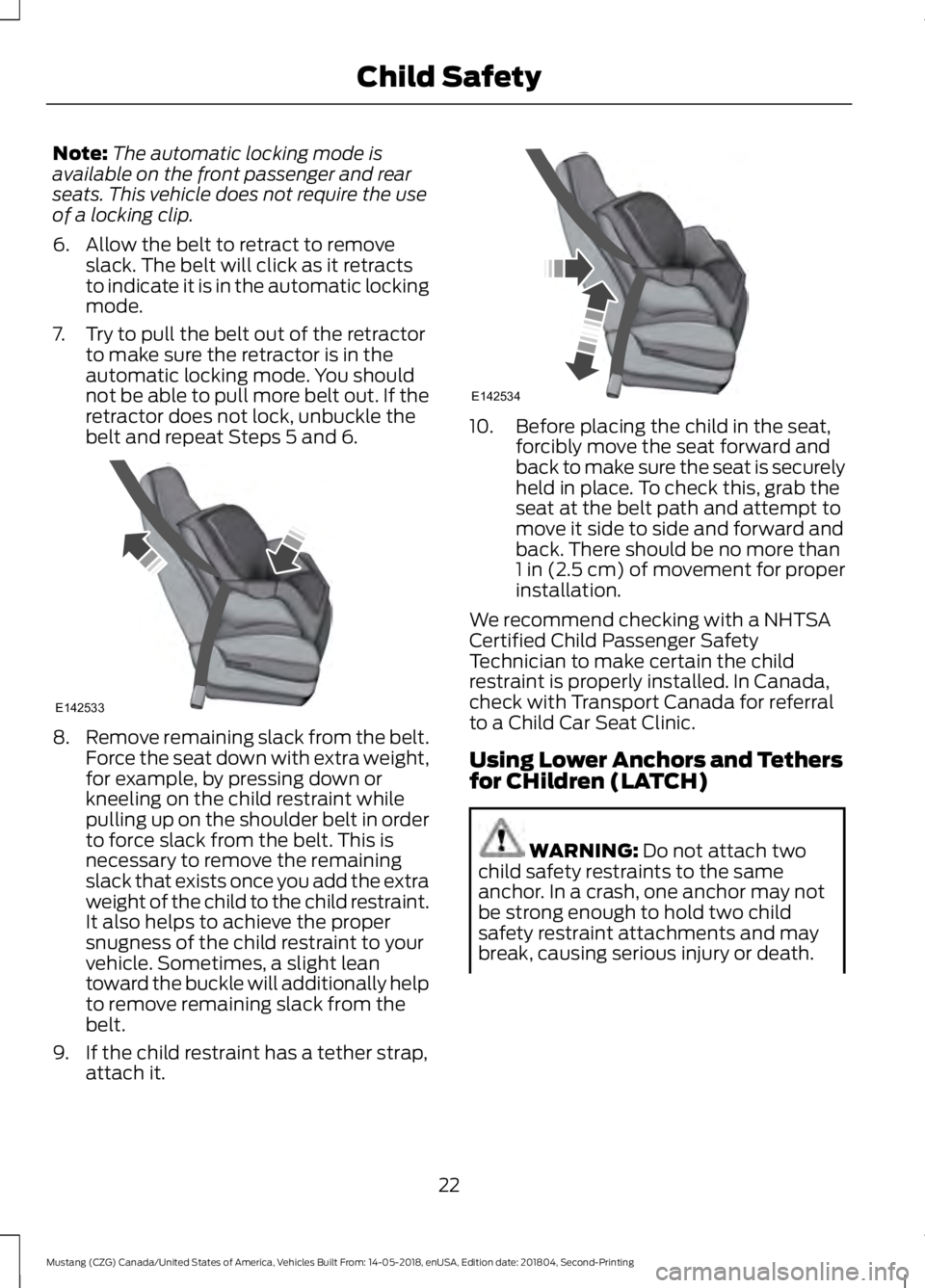
Note:
The automatic locking mode is
available on the front passenger and rear
seats. This vehicle does not require the use
of a locking clip.
6. Allow the belt to retract to remove slack. The belt will click as it retracts
to indicate it is in the automatic locking
mode.
7. Try to pull the belt out of the retractor to make sure the retractor is in the
automatic locking mode. You should
not be able to pull more belt out. If the
retractor does not lock, unbuckle the
belt and repeat Steps 5 and 6. 8.
Remove remaining slack from the belt.
Force the seat down with extra weight,
for example, by pressing down or
kneeling on the child restraint while
pulling up on the shoulder belt in order
to force slack from the belt. This is
necessary to remove the remaining
slack that exists once you add the extra
weight of the child to the child restraint.
It also helps to achieve the proper
snugness of the child restraint to your
vehicle. Sometimes, a slight lean
toward the buckle will additionally help
to remove remaining slack from the
belt.
9. If the child restraint has a tether strap, attach it. 10. Before placing the child in the seat,
forcibly move the seat forward and
back to make sure the seat is securely
held in place. To check this, grab the
seat at the belt path and attempt to
move it side to side and forward and
back. There should be no more than
1 in (2.5 cm) of movement for proper
installation.
We recommend checking with a NHTSA
Certified Child Passenger Safety
Technician to make certain the child
restraint is properly installed. In Canada,
check with Transport Canada for referral
to a Child Car Seat Clinic.
Using Lower Anchors and Tethers
for CHildren (LATCH) WARNING: Do not attach two
child safety restraints to the same
anchor. In a crash, one anchor may not
be strong enough to hold two child
safety restraint attachments and may
break, causing serious injury or death.
22
Mustang (CZG) Canada/United States of America, Vehicles Built From: 14-05-2018, enUSA, Edition date: 201804, Second-Printing Child SafetyE142533 E142534
Page 28 of 495
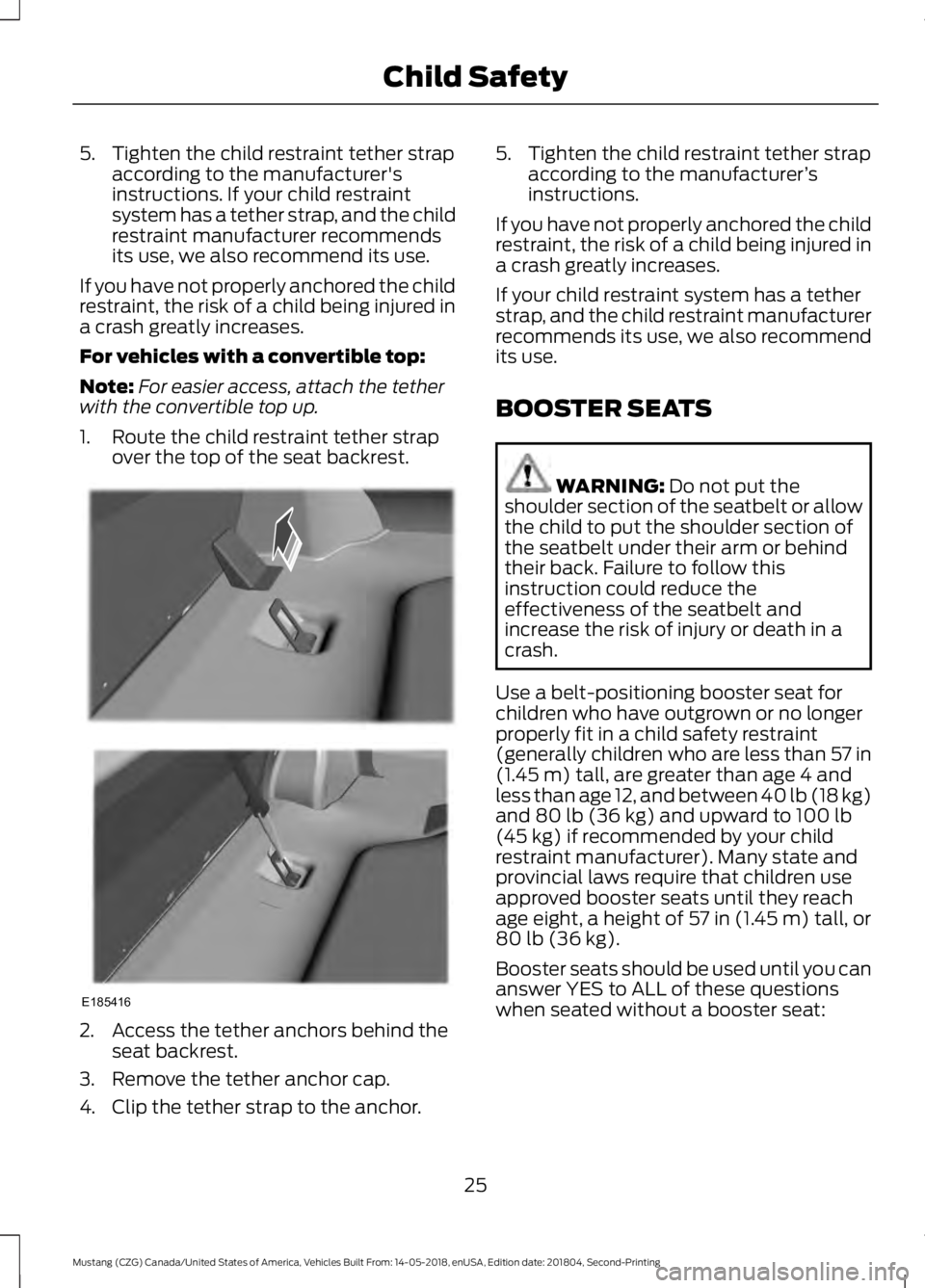
5. Tighten the child restraint tether strap
according to the manufacturer's
instructions. If your child restraint
system has a tether strap, and the child
restraint manufacturer recommends
its use, we also recommend its use.
If you have not properly anchored the child
restraint, the risk of a child being injured in
a crash greatly increases.
For vehicles with a convertible top:
Note: For easier access, attach the tether
with the convertible top up.
1. Route the child restraint tether strap over the top of the seat backrest. 2. Access the tether anchors behind the
seat backrest.
3. Remove the tether anchor cap.
4. Clip the tether strap to the anchor. 5. Tighten the child restraint tether strap
according to the manufacturer ’s
instructions.
If you have not properly anchored the child
restraint, the risk of a child being injured in
a crash greatly increases.
If your child restraint system has a tether
strap, and the child restraint manufacturer
recommends its use, we also recommend
its use.
BOOSTER SEATS WARNING: Do not put the
shoulder section of the seatbelt or allow
the child to put the shoulder section of
the seatbelt under their arm or behind
their back. Failure to follow this
instruction could reduce the
effectiveness of the seatbelt and
increase the risk of injury or death in a
crash.
Use a belt-positioning booster seat for
children who have outgrown or no longer
properly fit in a child safety restraint
(generally children who are less than
57 in
(1.45 m) tall, are greater than age 4 and
less than age 12, and between 40 lb (18 kg)
and
80 lb (36 kg) and upward to 100 lb
(45 kg) if recommended by your child
restraint manufacturer). Many state and
provincial laws require that children use
approved booster seats until they reach
age eight, a height of
57 in (1.45 m) tall, or
80 lb (36 kg).
Booster seats should be used until you can
answer YES to ALL of these questions
when seated without a booster seat:
25
Mustang (CZG) Canada/United States of America, Vehicles Built From: 14-05-2018, enUSA, Edition date: 201804, Second-Printing Child SafetyE185416
Page 29 of 495
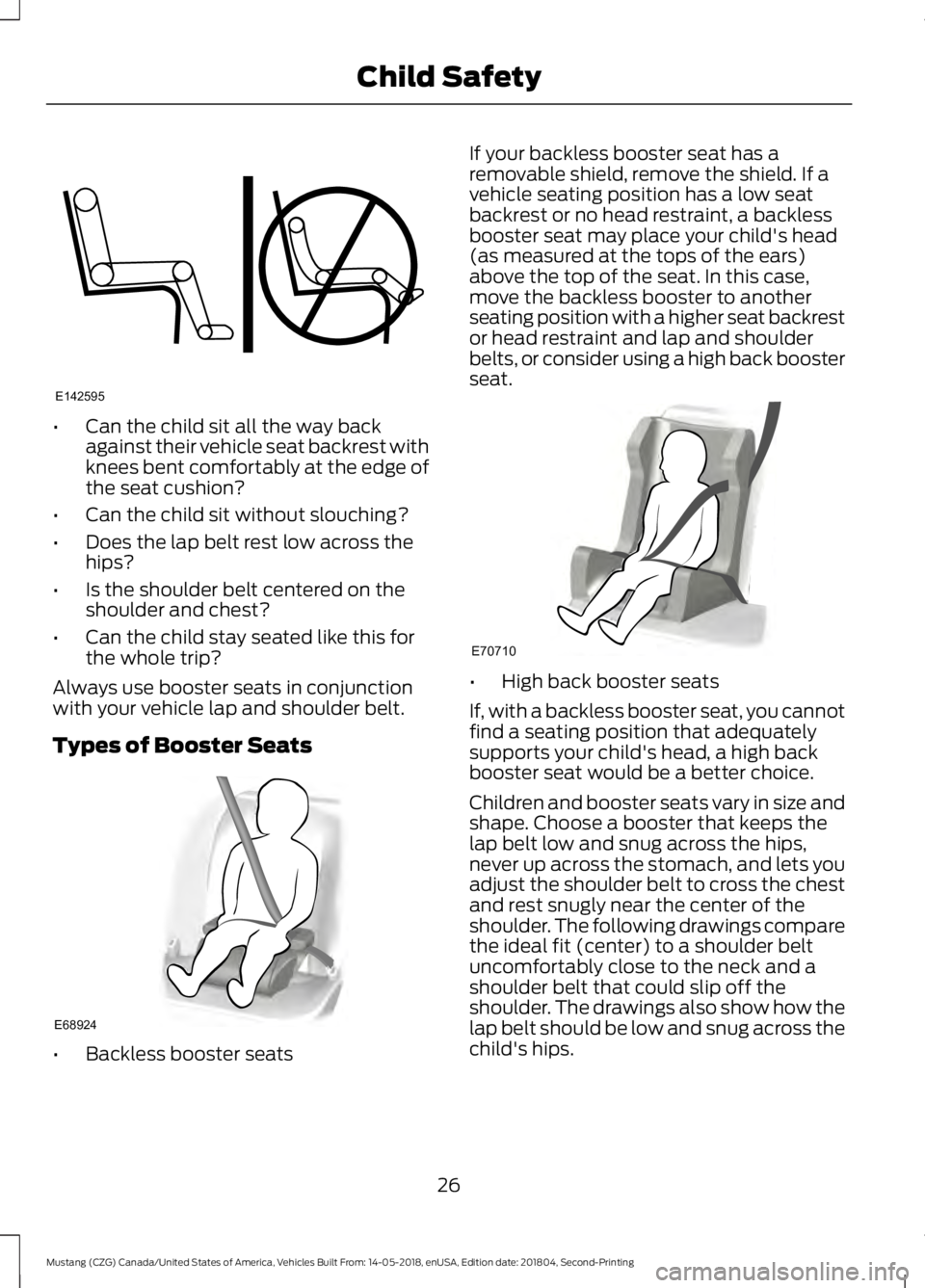
•
Can the child sit all the way back
against their vehicle seat backrest with
knees bent comfortably at the edge of
the seat cushion?
• Can the child sit without slouching?
• Does the lap belt rest low across the
hips?
• Is the shoulder belt centered on the
shoulder and chest?
• Can the child stay seated like this for
the whole trip?
Always use booster seats in conjunction
with your vehicle lap and shoulder belt.
Types of Booster Seats •
Backless booster seats If your backless booster seat has a
removable shield, remove the shield. If a
vehicle seating position has a low seat
backrest or no head restraint, a backless
booster seat may place your child's head
(as measured at the tops of the ears)
above the top of the seat. In this case,
move the backless booster to another
seating position with a higher seat backrest
or head restraint and lap and shoulder
belts, or consider using a high back booster
seat.
•
High back booster seats
If, with a backless booster seat, you cannot
find a seating position that adequately
supports your child's head, a high back
booster seat would be a better choice.
Children and booster seats vary in size and
shape. Choose a booster that keeps the
lap belt low and snug across the hips,
never up across the stomach, and lets you
adjust the shoulder belt to cross the chest
and rest snugly near the center of the
shoulder. The following drawings compare
the ideal fit (center) to a shoulder belt
uncomfortably close to the neck and a
shoulder belt that could slip off the
shoulder. The drawings also show how the
lap belt should be low and snug across the
child's hips.
26
Mustang (CZG) Canada/United States of America, Vehicles Built From: 14-05-2018, enUSA, Edition date: 201804, Second-Printing Child SafetyE142595 E68924 E70710